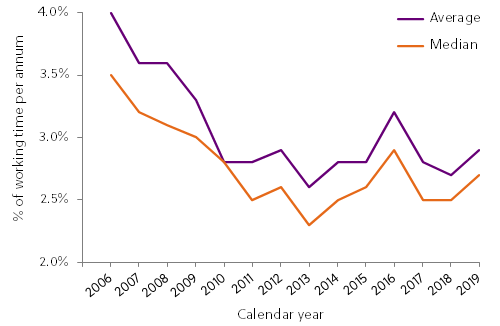Despite the slight increase, overall sickness absence rates remain some way off the high rates of 2006, when XpertHR first started gathering data, and the median percentage of working time lost to sickness absence has not risen above 3.0% since 2009.
Chart 1: Absence rates for all employers, % of working time per annum, 2006-2019

Source: XpertHR.
Changes to sickness absence policies in light of the coronavirus pandemic
The survey found that many employers are now planning changes to their organisations’ sickness absence policies in the wake of the coronavirus pandemic. Half of those taking part in the latter stages of the survey said this was the case (see notes below).
Changes identified in the survey include:
- paying all staff occupational sick pay when they are absent due to Cofid-19 symptoms, irrespective of length of service or contractual obligations;
- offering full pay to those who have to isolate but cannot work from home; and.
- recording sickness absence due to Covid-19 but are not including it for the purpose of assessing any absence triggers or targets.
Cost of absence
The cost of sickness absence in 2019 stood at a median of £568 and an average of £544 per employee. As is consistently the case, this is unlikely to be an accurate measurement of the overall cost of sickness absence - more than four in 10 (42%) told us they did not know if their absence costs data was accurate or not, and just 16% believe it is very accurate.
One reason for this is the narrow view taken on what to include when assessing the cost of sickness absence. While all our respondents include the salaries of individuals on sick leave, few count the cost of overtime, reduced performance, service or missed business opportunities.
XpertHR senior HR practice editor Noelle Murphy said:
“While it will take some time for the full impact of Covid-19 on sickness absence rates to become clear, one thing remains striking: how much HR and employers underestimate the total cost of sickness absence. With the onslaught of the current stark recession, employers need to keep all costs under control – including sickness absence. But without meaningful and accurate data, employers are in the dark about the true cost and, therefore, any savings that can be made through effective and thoughtful management of sickness absence.”
Absence rates for all employers, 2006-2018 |
||
Calendar year |
% of working time, median |
days per employee, median |
|
2019 |
2.7 |
6.4 |
|
2018 |
2.5 |
5.6 |
|
2017 |
2.5 |
5.6 |
|
2016 |
2.9 |
6.6 |
|
2015 |
2.6 |
5.8 |
|
2014 |
2.5 |
5.7 |
|
2013 |
2.3 |
5.2 |
|
2012 |
2.6 |
5.9 |
|
2011 |
2.5 |
5.7 |
|
2010 |
2.8 |
6.4 |
|
2009 |
3.0 |
6.8 |
|
2008 |
3.1 |
7.1 |
|
2007 |
3.2 |
7.4 |
|
2006 |
3.5 |
8.0 |
|
Source: XpertHR. |
||






